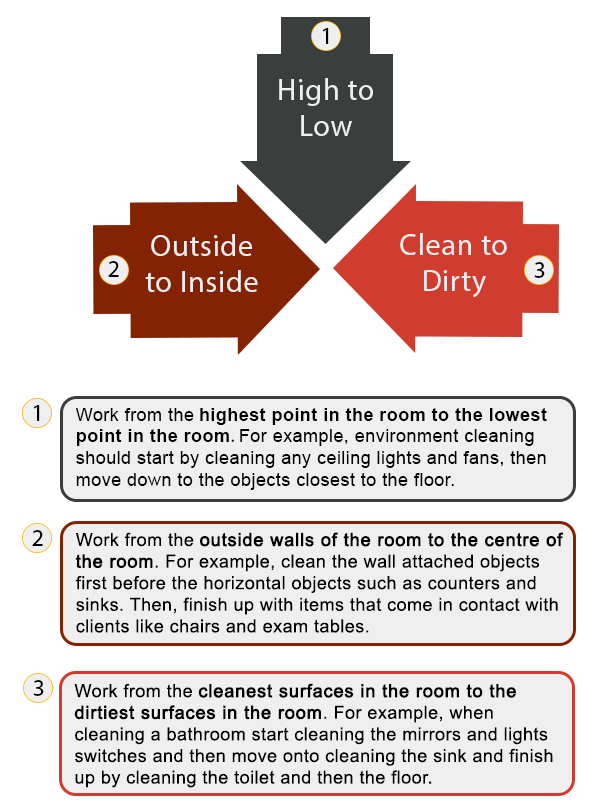3.4 Managing a Custodial Program
Step 1: The Plan
There are a number of steps involved in managing a successful custodial program, starting with a plan. The plan involves evaluating the square footage of the facility, floor types, room types, fixtures in the rooms, and the equipment that the team will work with to do the job. Analyzing this will help you decide how many staff you need and what tasks they will do in each area.
| Net Cleanable Square Footage: | Areas that require cleaning. May not include closets, storage areas, or offices. |
|---|---|
| Floor Types: | Carpet vs. Tile. |
| Room Types: | Kitchens versus Dining Rooms versus Patient Rooms |
| Fixtures in the Rooms: | Lights versus Ceiling Fans, Tables versus Shelves |
| Equipment: | Mops, Steam Cleaners, Vacuums, Chemicals, Carts, PPE |
Once you have a plan in place, it is time to share the plan with the staff.
Step 2: Education and Staff Training
Training staff on cleaning and disinfectant basics starts with how to manage a room or area. Cleaners should work from the highest point in the room to the lowest point in the room, from outside walls to the centre of the room, and from the cleanest surfaces in the room to the dirtiest. For example, in a bathroom, start with the mirrors and light switches and move to the sink, finish with the toilet.
There are three basic rules when cleaning a room or an area:

Image Description
Three arrows highlight the cleaning basics: 1 – High to Low, 2 – Outside to Inside, and 3 – Clean to Dirty. These are fully explained below.
1 – Work from the highest point in the room to the lowest point in the room. For example, environment cleaning should start by cleaning any ceiling lights and fans, then move down to the objects closest to the floor.
2 – Work from the outside walls of the room to the centre of the room. For example, clean the wall-attached objects first before the horizontal objects, such as counters and sinks. Then, finish up with items that come in contact with clients, like chairs and exam tables.
3 – Work from the cleanest surfaces in the room to the dirtiest surfaces in the room. For example, when cleaning a bathroom, start cleaning the mirrors and light switches, and then move on to cleaning the sink and finish up by cleaning the toilet and then the floor.
Education and staff training should also include workplace hazardous materials information system (WHMIS) training, preparing the staff to work with workplace chemicals and disinfectants. Personal protective equipment should also be included in staff training. (Note: see 3.3 Chemicals and Personal Protective Equipment for information on chemicals and personal protective equipment specific to environmental services.)
Step 3: Quality Assurance
Quality assurance or ensuring that standards are met involves auditing and corrective action. The first task of the quality assurance process is to develop an audit. An audit is a list of standards or expectations that need to be met by the staff. Auditing provides an opportunity to inspect the end results of the cleaning process and ensure that staff are compliant in meeting the set standards. It provides a chance for corrective actions. Correct actions are actions that can be taken to correct an issue. For example, you notice that the chairs in the dining room have not been cleaned and sanitized as required by the audit. Is this because the workload is too heavy on that shift? Do the staff need more time? Or is it because some residents are a bit slower leaving the dining room after a meal? Does the order of the work need to be adjusted so the staff can access the chairs at a later time in their shift? Maybe the results of the audit lead to a few questions that require a bit of investigative work. Get the information you need to make a decision and put the correct action in place.
Example Audit for Dining Room Cleaning and Sanitation:
| Item | Comply: Yes/No | Comments | Corrective Action |
|---|---|---|---|
| Vents & Lighting Clean |
☐ |
||
| Windows Clean, Smear Free |
☐ |
||
| Walls and Baseboards Clean |
☐ |
||
| Soiled Linens Removed |
☐ |
||
| Recycling Bins & Garbages Emptied and Cleaned |
☐ |
||
| Tables and Chairs Cleaned and Sanitized |
☐ |
||
| Table Condiments and Common Items Wiped, Cleaned, and Refilled |
☐ |
||
| Service Counters Cleaned and Sanitized |
☐ |
||
| Floor Free from Debris |
☐ |

